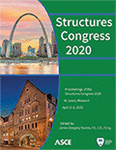Structures Congress 2020
Partial Damage Distribution and Progressive Collapse of Buildings
Publication: Structures Congress 2020
ABSTRACT
The prevailing analysis approach in the field of disproportionate collapse of structures is the alternate path method (APM). This method adopts the notion of a complete removal of a key load-bearing component of the system, such as a column or a shear wall, and investigates the capability of the remaining structure to bridge over the loss of this component. Though it offers a practical and efficient tool for the assessment of structural robustness, the complete column loss scenario is a rather unrealistic idealization of damage initiation. This study expands on previous work done by the authors in the field of structural robustness and applies a partial distributed damage method (PDDM) in 3D multi-story steel framed and concrete composite buildings. This method assumes that damage is being distributed in more than one components, as a common output of real-case extreme events. Using advanced nonlinear finite element modeling, this work applies a PDDM scenario in a prototype structural system and evaluates its mechanical performance, making direct comparisons with the APM with regards to the governing collapse mechanism, structural capacity, and damage progression path.
Get full access to this article
View all available purchase options and get full access to this chapter.
REFERENCES
Alashker, Y., El-Tawil, S. “A design-oriented model for the collapse resistance of composite floors subjected to column loss”, Journal of Constructional Steel Research, 67, pp. 84-92, 2011.
Alashker, Y., Li, El-Tawil, S. “Approximations in progressive collapse modeling”, Journal of Structural Engineering”, 137: 914-924, 2011.
Bao, Y., Lew, H.S., Kunnath, S.K. “Modeling of reinforced concrete assemblies under column-removal scenario”, Journal of Structural Engineering, 140, 2014.
Bazant, Z., Christensen, M. “Long-wave extensional buckling of large regular frames”, Journal of the Structural Division, 98(10): 2269-2289, 1972.
Bazant, Z., Christensen, M. “Continuum solutions for long-wave extensional buckling of regular frames”, International Journal of Engineering Science, 98(10): 2269-2289, 1973.
Department of Defence - Unified Facilities Criteria (UFC), “Design of buildings to resist progressive collapse”, Washington, DC, 2017.
Dinu, F., Marigean, I., Dubina, D., Petran, I. “Experimental testing and numerical analysis of 3D steel frame system under column loss”, Engineering Structures, 113: 59-70, (2016).
Ellingwood, B.R., “Load and resistance factor criteria for progressive collapse”, available from http://www.nibs.org, 2012.
FEMA-355C. “State of the art report on systems performance of steel moment frames subject to earthquake ground shaking”, Washington, DC, Federal Emergency Management Agency, 2000.
Foley, C., Martin, K., Schneeman, C. “Robustness in structural steel framing systems”, Final Report submitted to American Institute of Steel Construction, Inc. Chicago, IL, 2007.
Gerasimidis, S. “Analytical assessment of steel frames progressive collapse vulnerability to corner column loss”, Journal of Constructional Steel Research, 95, pp. 1-9, 2014.
Gerasimidis, S., Deodatis, G., Kontoroupi, T., Ettouney, M. “Loss-of-stability induced progressive collapse modes in 3D steel moment frames”, Structure and Infrastructure Engineering, 11, No. 3, pp. 334-344, 2015.
Gerasimidis, S., Deodatis, G., Yan, Y., Ettouney, M. “Global instability induced failure of tall steel moment frame buildings”, Journal of Performance of Constructed Facilities, 04016082, 2016.
Gerasimidis, S., Sideri, J. “A new partial-distributed damage method for progressive collapse analysis of steel frames”, Journal of Constructional Steel Research, 119, pp. 233-245, 2016.
Gouverneur, D., Caspeele, R., Taerwe, L., “Experimental testing and numerical analysis of 3D steel frame system under column loss”, Engineering Structures, 49: 1007-1016, 2013.
Izzudin, B.A., Vlassis, A.G., Elghazouli, A.Y., Nethercot, D.A.“Progressive collapse of multi-storey buildings due to sudden column loss – Part I: Simplified assessment framework”, Engineering Structures, 30: 1308-1318, 2008.
Johnson, E.S., Meissner, J.E., Fahnestock, L.A., “Experimental behavior of a half-scale steel concrete composite floor system subjected to column removal scenarios”, Journal of Structural Engineering, 142(2), 2015.
Kachanov, L. “Introduction to continuum damage mechanics”, Springer, Brookline, MA, 1986.
Kwasniewski, L. “Nonlinear dynamic simulations of progressive collapse for a multi-story building”, Engineering Structures, 32, pp. 1223-1235, 2010.
Li, H., El-Tawil, S. “Three-dimensional effects and collapse resistance mechanisms in steel frame buildings”, Journal of Structural Engineering, 140, 2014.
Main, J.A., “Composite floor systems under column loss: collapse resistance and tie force requirements”, Journal of Structural Engineering, 140(8), A4014003, 2014.
Oosterhof, S., Driver, G. “Behavior of steel shear connections under column-removal demands”, Journal of Structural Engineering, 141, No. 4, 04014126, 2014.
Pantidis, P., Gerasimidis, S. “New Euler-type progressive collapse curves for steel frames”, Proc. Of Annual Stability Conference, Structural Stability Research Council, Orlando, FL, 2016.
Pantidis, P., Gerasimidis, S. “New Euler-type progressive collapse curves for steel moment resisting frames: an analytical method”, Journal of Structural Engineering, 143(9), 04017113, 2017a.
Pantidis, P., Gerasimidis, S. “Loss-of-stability vs yielding-type collapse mode in 3D steel structures under a column removal scenario”, Proc. Of Annual Stability Conference, Structural Stability Research Council, San Antonio, TX, 2017b.
Pantidis, P., Gerasimidis, S. “Progressive collapse of 3D steel composite buildings under interior gravity column loss”, Journal of Constructional Steel Research, 150: 60-75, 2018a.
Pantidis, P., Hill, T., Gerasimidis, S., “The impact of gravity connections on the progressive collapse response of steel framed and concrete composite buildings”, Proc. Of Annual Stability Conference, Structural Stability Research Council, Baltimore, MD, 2018b.
Sideri, J., Mullen, C., Gerasimidis, S., Deodatis, G. “Distributed column damage effect on progressive collapse vulnerability in steel buildings exposed to an external blast event”, Performance of Constructed Facilities, 31(5), 04017077, 2017.
Simulia, ABAQUS theory manual, Dassault Systems Simulia Corporation, 2012.
Weigand, J., Berman, J. “Integrity of Steel Single Plate Shear Connections Subjected to Simulated Column Removal”, Journal of Structural Engineering. 140(5): 04013114, 2014.
US General Service Administration (GSA). “Alternate path analysis design guidelines for progressive collapse resistance”, 2016.
Information & Authors
Information
Published In
ISBN (Online): 978-0-7844-8289-6
Copyright
© 2020 American Society of Civil Engineers.
History
Published online: Apr 2, 2020
Authors
Metrics & Citations
Metrics
Citations
Download citation
If you have the appropriate software installed, you can download article citation data to the citation manager of your choice. Simply select your manager software from the list below and click Download.
